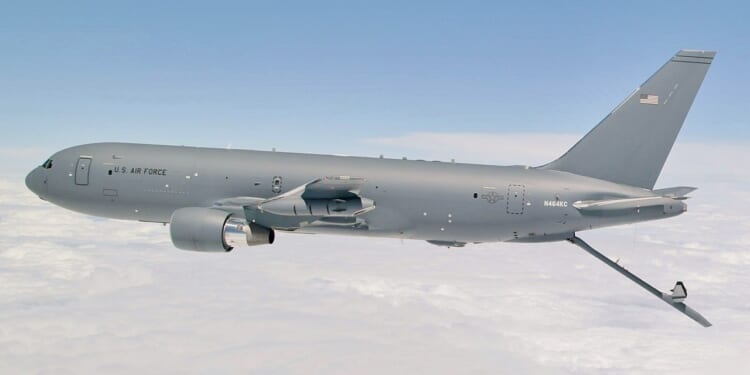In any conflict with China, aerial refueling will determine whether US fighters and bombers can operate from safe stand-off distances across the vast expanses of the Indo-Pacific.
America’s grand strategy emphasizes a perpetual presence around the world, requiring its fleet to have an immense range. To maximize this range, the United States relies upon aircraft that can reach further and stay longer, to dictate air space in far-flung locations.
For the US Air Force, maximizing range depends upon a lesser-known, less glamorous, yet vital platform—the aerial tanker. Today, the workhorse of the tanker mission is in transition, from the Eisenhower-era Boeing KC-135 Stratotanker to the Boeing KC-46A Pegasus. More than just a simple upgrade, the KC-46 is a bridge between traditional fuel logistics and the digitally networked battlespace of the future.
The KC-46A Pegasus’ Specifications
- Year Introduced: 2019
- Number Built: ~100 (all operators); 180 planned for US Air Force, with additional orders from Japan and Israel
- Length: 165 ft 6 in (50.5 m)
- Wingspan: 157 ft 8 in (48.1 m)
- Weight (MTOW): ~415,000 lb (188,240 kg)
- Engines: Two Pratt & Whitney PW4062 high-bypass turbofan engines (~62,000 lbf thrust each)
- Top Speed: ~567 mph (913 km/h)
- Range: ~6,385 nmi (7,350 mi, 11,825 km)
- Service Ceiling: ~43,000 ft (13,100 m)
- Loadout: Up to 65,000 lb (29,500 kg) of cargo; can carry 18 standard 463L pallets; up to 114 passengers or 58 patients (aeromedical configuration)
- Crew: Typically 3 (pilot, copilot, and boom operator)
The KC-46 Tanker’s Commercial Roots
Developed from the Boeing 767-2C commercial airframe, the KC-46 combines proven civilian reliability with new-generation military systems. The heart of the platform is its fuel capacity and distribution; the KC-46 can carry 212,000 pounds of fuel, which can be offloaded through both a fly-by-wire refueling boom and hose-and-drogue pods to support virtually every US and allied aircraft in the sky. The KC-46 can carry a vast array of different cargoes, too, making it an invaluable logistics platform as well as an aerial refueler.
The KC-46 also features an impressive sensor and network suite. The Remote Vision System 2.0 allows the boom operator to conduct refueling from a console using 3-D cameras, rather than lying prone in a windowed bay like boom operators on the KC-135. The cockpit is fully digital, with heads-up display, touchscreen avionics, and Link 16 data connectivity—which effectively turns the tanker into a flying node within the Air Force’s greater network. So in principle, while serving as a refueler, the KC-46 could also relay targeting data, serve as a communications bridge, or even coordinate autonomous systems.
The Boeing program has not been without turbulence. Early models of the KC-46 suffered from vision-system distortion, fuel-leak issues, and boom stiffness that limited deployment. Boeing and the Air Force have already poured years of re-engineering into fixes, and finally, the KC-46 seems to be approaching full operational capability. Over 180 airframes are expected to enter service, to fully replace the aging KC-135s (most of which are over 60 years old). The KC-46 is also a candidate for export, with Japan and Israel placing orders.
Like so many emerging military technologies, the KC-46 is calibrated towards conflict with China. In any conflict with China, aerial refueling will determine whether US fighters and bombers can operate from safe stand-off distances across the vast expanses of the Indo-Pacific. And the KC-46 has been designed with a contested environment in mind—with infrared missile-warning sensors, electronic countermeasures, and ballistic-tolerant fuel tanks.
Of course, the KC-46 is not invincible—and does not feature a stealth profile. Accordingly, the KC-46 is likely a bridge platform expected to serve into the 2050s, not the true long-term future of US aerial refueling. For that, the Air Force is already studying the Next Generation Air-Refueling System (NGAS), a stealthy, possibly autonomous refueler capable of penetrating denied airspace.
About the Author: Harrison Kass
Harrison Kass is a senior defense and national security writer at The National Interest. Kass is an attorney and former political candidate who joined the US Air Force as a pilot trainee before being medically discharged. He focuses on military strategy, aerospace, and global security affairs. He holds a JD from the University of Oregon and a master’s in Global Journalism and International Relations from NYU.
Image: Wikimedia Commons.

















